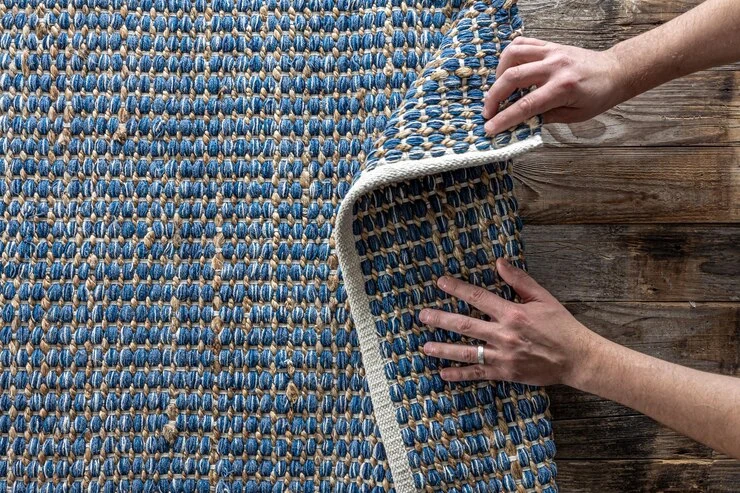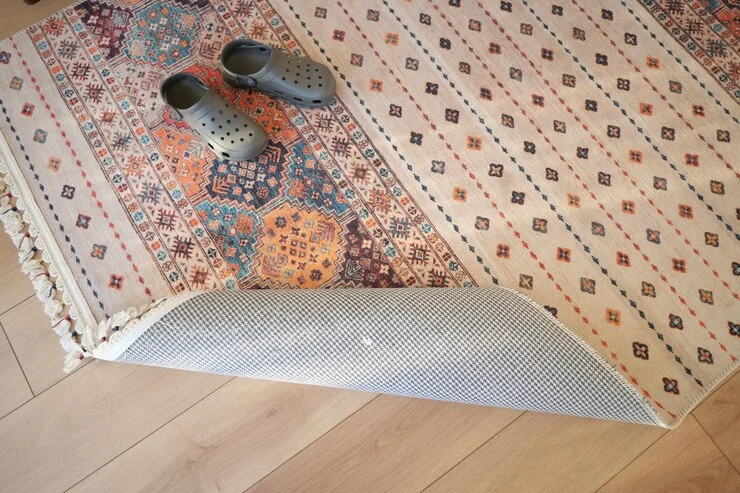Rugs add style and comfort to any home. However, they can be tricky on carpeted floors. Rugs often slide, bunch up, or shift out of place. This affects the room’s look and can be unsafe. This guide offers simple and effective solutions on how to keep rugs from sliding on carpet. Learn how to keep your rugs secure on carpets.
Why Do Rugs Slide on Carpet?
Rugs slide on carpets due to low friction. Pressure from walking makes them shift. This is common on plush or high-pile carpets. Here are the main reasons rugs move on carpets:
- Low Friction: Rugs and carpets often don’t grip well together.
- Foot Traffic: Continuous walking can push rugs out of place.
- No Anti-Slip Features: Many rugs lack backing material designed to prevent slipping.
Knowing these causes is the first step to solving the problem effectively.
The Problems Caused by Sliding Rugs
Rugs that don’t stay in place can cause several issues, including:
- Safety Hazards: Sliding rugs can lead to slips and falls, which can be particularly dangerous for children and elderly individuals.
- Aesthetic Problems: A constantly moving rug can disrupt the overall look of your space, making it appear messy.
- Damage to Rugs and Carpet: Sliding can cause excessive wear and tear on both your rug and the underlying carpet, shortening their lifespan.
Now that we understand the problems, let’s look at ways to solve them.
Effective Solutions to Keep Rugs from Sliding on Carpet
Let’s delve into the most effective ways to secure your rug. Each method is easy to implement and budget-friendly.
Use a Rug Pad Designed for Carpet
Investing in a rug pad specifically designed for carpet is one of the most effective solutions. These pads create friction between the rug and carpet, preventing movement. Choose pads that say ‘non-slip’ or ‘suitable for carpet’ on the label.
Benefits of Rug Pads
- Enhanced grip and stability.
- Added cushioning for extra comfort.
- Protects both the rug and carpet from wear and tear.
Ensure you purchase a pad slightly smaller than your rug or trim it to fit perfectly.
Apply Double-Sided Carpet Tape
Double-sided carpet tape is a quick and budget-friendly solution to keep rugs in place. This adhesive tape sticks to both the rug and carpet, holding them together firmly.
Tips for Using Carpet Tape
- Make sure the rug and carpet are clean before using the tape.
- Try the tape on a small spot first to check it won’t harm your carpet.
- Replace the tape periodically for maximum effectiveness.
Try Non-Slip Rug Grippers
Non-slip rug grippers are small, adhesive pads that stick to the corners or edges of your rug. These grippers create a strong bond with the carpet, ensuring your rug stays put.
How to Use Rug Grippers
- Clean the bottom of the rug and the carpet.
- Attach the grippers to the corners of the rug.
- Press down firmly to secure them in place.
Grippers are reusable and easy to clean, making them a practical choice.
Opt for Rugs with Non-Slip Backing
Some rugs come with a built-in non-slip backing designed to prevent movement. These rugs are ideal for use on carpets and eliminate the need for additional accessories.
Features to Look For
- Rubber or latex backing.
- Textured surface for added grip.
If you already own a rug without a non-slip backing, consider pairing it with a rug pad or grippers.
Anchor the Rug with Furniture
Positioning heavy furniture on top of your rug can help keep it in place. This method is especially effective for larger rugs.
Furniture Placement Tips
- Use furniture with wide bases for better anchoring.
- Avoid placing furniture too close to the edges of the rug to prevent curling.
While this method is effective, it may not be suitable for smaller rugs or high-traffic areas.
Use Silicone Caulk
For a DIY solution, silicone caulk can be applied to the underside of the rug. This creates a textured, grippy surface that helps prevent sliding.
How to Apply Silicone Caulk?
- Turn the rug upside down.
- Apply small lines or dots of silicone caulk.
- Allow it to dry completely before placing the rug back on the carpet.
This method is affordable and long-lasting, but it’s best suited for rugs that don’t need frequent repositioning.
Layer Rugs Strategically
Layering a smaller rug on top of a larger, heavier rug can provide extra stability. The weight and size of the bottom rug create a foundation that keeps the top rug in place.
Best Practices for Layering
- Choose rugs with complementary colors and patterns.
- Ensure the bottom rug has a non-slip backing or use a rug pad for added grip.
Layering is a stylish solution that works well in living rooms and bedrooms.

Additional Tips for Rug Stability
Regular Maintenance and Adjustment
Even with the best solutions, occasional maintenance is necessary to keep rugs looking neat and secure.
Maintenance Tips
- Vacuum both the rug and carpet regularly to remove dust and debris.
- Straighten and realign the rug periodically, especially in high-traffic areas.
- Check and replace worn-out rug pads, grippers, or tape as needed.
Consider the Material of Your Rug
The material of your rug affects how well it stays in place. Heavier materials like wool or jute are less likely to move compared to lightweight synthetic rugs.
Best Rug Materials for Carpet
- Wool: Durable and naturally grippy.
- Jute: Adds texture and stability.
- Cotton: Lightweight but can be anchored effectively with pads or grippers.
Choose materials based on your aesthetic preferences and functional needs.
Professional Solutions for Stubborn Rugs
If your rug continues to slide despite trying the above methods, consider seeking professional help. Carpet and rug specialists can provide tailored solutions, such as custom rug pads or adhesive treatments.
When to Seek Professional Help
- Persistent movement despite DIY efforts.
- High-value rugs requiring special care.
- Unique carpet textures or surfaces.
Professionals ensure a secure fit without causing damage to your rug or carpet.
Potential Risks and Considerations
While these solutions are effective, it’s essential to consider potential risks. Adhesive products can leave residues or damage carpet fibers upon removal. Always test a small area first and follow manufacturer instructions to mitigate any issues.
Common Mistakes to Avoid
- Using the Wrong Tape: Not all tapes are carpet-friendly. Ensure you use double-sided tape designed for carpets to prevent damage.
- Ignoring Rug Size: A rug that’s too small is more prone to slipping. Ensure your rug is appropriately sized for the space.
- Skipping the Underlay: Thinking your rug will stay put without assistance can lead to slips and trips. Invest in a quality non-slip pad.
FAQs
How do I keep my rug from curling or bunching up on the carpet?
Use rug grippers, a non-slip rug pad, or double-sided tape to secure the edges and prevent curling or bunching.
What is the best way to keep a rug in place?
A high-quality non-slip rug pad designed for carpets is the most effective solution for holding rugs securely.
How to stop a rug from sliding on hard floors (wood, tile, or laminate)?
Use a non-slip rug pad made for hard surfaces, silicone caulk, or anti-slip sprays to secure the rug on wood, tile, or laminate floors.
Conclusion
Keeping rugs from sliding on carpet may seem challenging, but with the right tools and techniques, you can enjoy a stable and stylish setup. Whether you opt for rug pads, grippers, or a DIY solution, addressing the root cause of rug movement ensures a safer and more aesthetically pleasing home. Try out these methods and choose the one that works best for your needs. With a little effort, you can say goodbye to sliding rugs for good!
